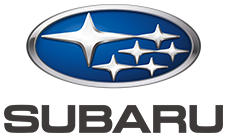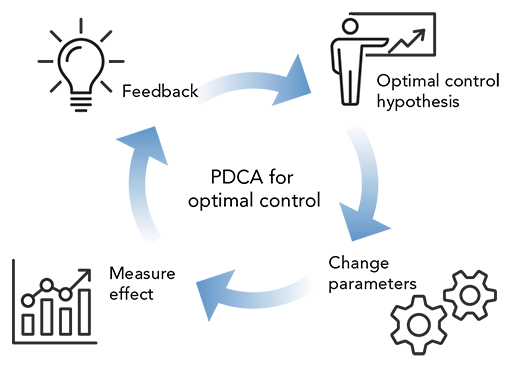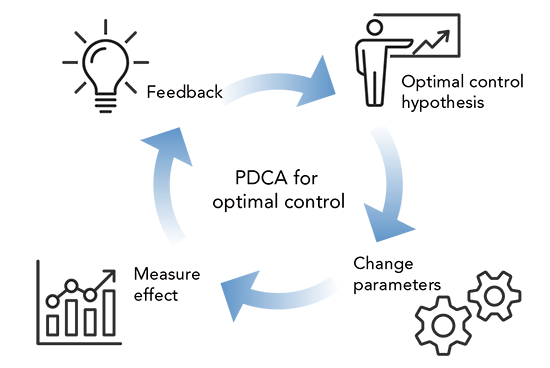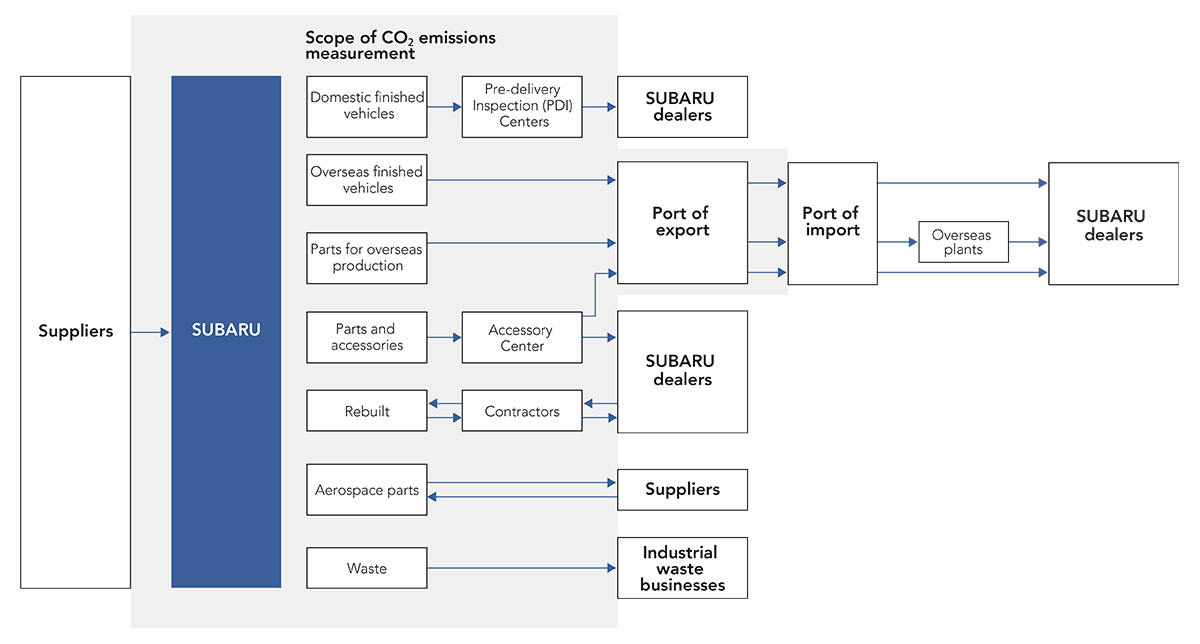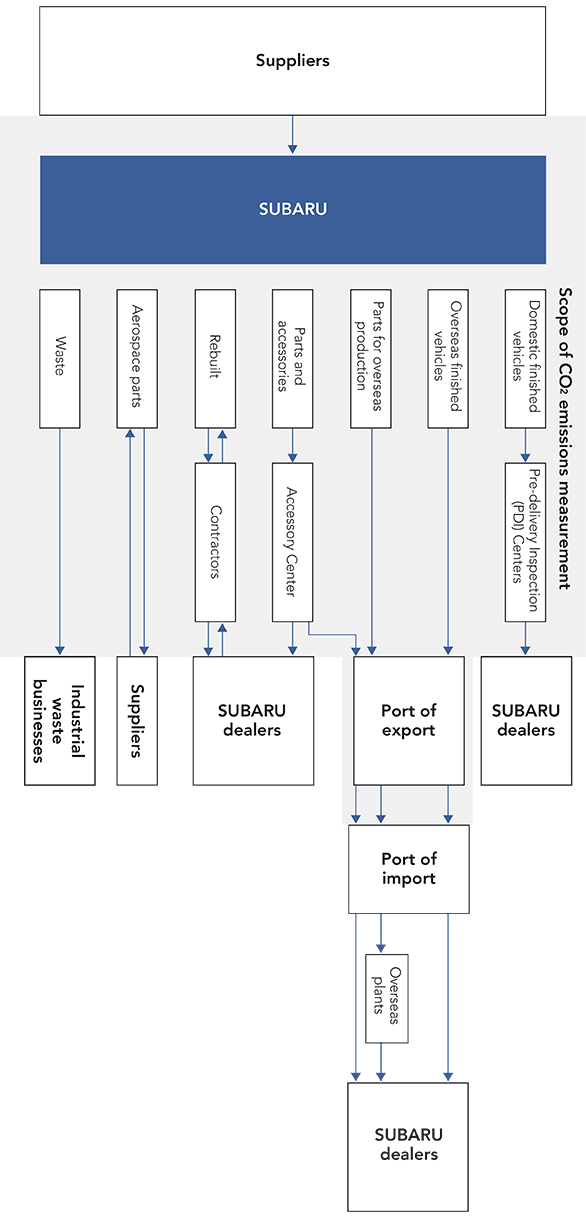Climate Change
- Our Approach
- Management System
- Risks and Opportunities Identified
- Strategy
- Risk Management
- Medium- to Long-term Goals (Long-term Vision and Milestones)
- Achievements
- Initiatives
- Gunma Plant
- Aerospace Company (Utsunomiya Plant and Handa Plant)
- Tokyo Office
- Offices
- Group companies in Japan
- Group companies overseas
- Distribution
- Sales
- Carbon Pricing
- External Partnerships
Our Approach
SUBARU recognizes that climate change is one of the most pressing global issues. Toward its target of achieving carbon neutrality by 2050, SUBARU will reduce CO2 emissions from its products, factories, and offices to help decarbonize society. Accordingly, it has set long-term goals, and is working to achieve them with medium-term goals as intermediate milestones.
Management System
SUBARU has established the Environment Committee for the purpose of promoting the sustainable growth of both society and the Company, and thereby contributing to global environment conservation. The committee discusses targets and measures from broad as well as medium- to long-term perspectives that accommodate environmental standards required by future societies, and evaluates the progress of related implementations and achievements.
The Environment Committee is chaired by the Executive Officer in charge of the Sustainability Division appointed by the Board of Directors. Details of discussions by the Environment Committee are reported to the Sustainability Committee. We also have a system for escalation and reporting to the Executive Management Board Meeting and Board of Directors to be used as necessary. Management of climate change-related activities is included in the responsibilities of the environmental management structure. Environmental risks and opportunities associated with climate change are assessed and monitored, and undergo management review. Then, particularly critical proposals are deliberated and decided at the Board of Directors. Each of the five bodies within the structure—Production & Environment Subcommittee, Global Warming Prevention Working Group, Domestic Affiliated Companies’ Environment Subcommittee, Sales and Service Environment Subcommittee, and Logistics Environment Subcommittee—meet twice a year for the purpose of monitoring.
In addition, in order to contribute to the realization of a decarbonized society through the reduction of CO2 emissions throughout the life cycle of our business activities, SUBARU holds monthly CN Promotion Meetings, bringing together departments representing the five areas of “product use,” “materials and components,” “transportation,” “disposal,” and “manufacturing.” In these CN Promotion Meetings, members from each area worked together and shared information, formulated a master plan from a medium- to long-term perspective, and took actions to visualize and mitigate emissions in each area in the interest of achieving carbon neutrality by 2050. SUBARU operates cross-company forums whose aim is CO2 reduction over the entire life cycle and whose activities are subject to the overall supervision of the Environment Committee as part of carbon neutrality initiatives.
Governance Structure for Climate Change
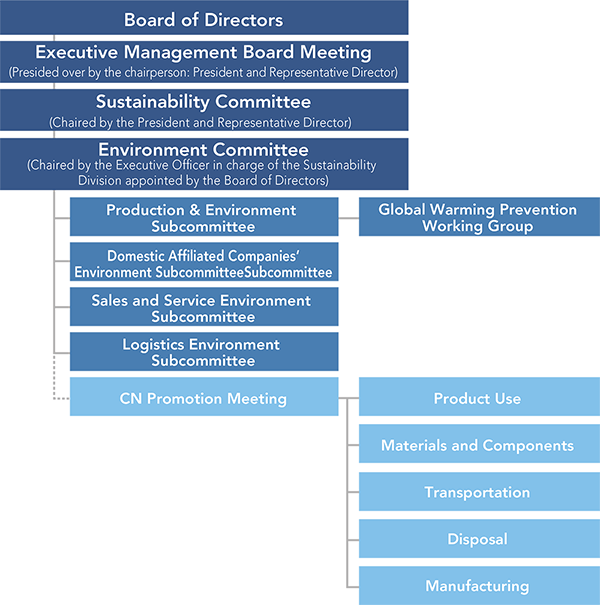
Risks and Opportunities Identified
SUBARU defines and identifies risks and opportunities associated with climate change to achieve sustainable business activities.
We have identified a number of risks associated with climate change. Initiatives to address climate change may be inadequate or abnormal weather may cause delays in procurement, production, and distribution. In addition, transition risks and physical risks may have impacts and outcomes that are currently extremely difficult to predict. Increased R&D expenses, lost sales opportunities due to reduced customer satisfaction and brand image, and delays in procurement, production, and distribution due to abnormal weather are among the potential impacts of these risks. These risks could have a material impact on the operating results and financial position of the SUBARU Group.
On the other hand, effective initiatives to address climate change could lead to opportunities to create new markets and employment and also use capital and energy more efficiently.
Main Risks Identified
Business Management in General
Reputational risk
① If SUBARU fails to implement adequate initiatives to achieve low-carbon/zero-carbon outcomes, its brand value could be harmed, which could affect the Company’s sales and recruiting ability. Capital costs could also rise, due to increased difficulty in obtaining financing from medium- and long-term investors.
Regulatory risk
② There is an argument that nationally determined contributions (NDCs) need to be expanded to be able to achieve the Paris Agreement’s “well below 2°C” target, and thus countries may revise their NDCs to set more stringent targets. Such revisions could have a significant impact on SUBARU’s business activities.
Acute physical risk
③ As an impact of climate change, extreme torrential rain will frequently cause floods in various locations, which could pose risks of SUBARU’s operations being affected by disrupted supply of raw materials and submerged factories.
Products
Regulatory risk
① If SUBARU fails to meet fuel economy regulations imposed in Japan, the U.S., Europe, and China, the Company could incur additional costs or losses related to negative incentives, such as fines or non-penal fines for legal violation, and credit purchase for unmet standards. Also, some of our products could fail to satisfy certain fuel economy standards, resulting in restrained sales opportunities.
Market risk
② At present, it is difficult to predict technological progress and price optimization for electrification, which will likely cause a substantial gap with the real state of market needs. In such a situation, SUBARU could incur unnecessary and excessive R&D costs while facing a decline in customer satisfaction, resulting in unexpected losses and reduced sales opportunities as well as hampered advancement of the Company’s electrification efforts.
③ SUBARU views electrification as a steady medium- to long-term trend, and also anticipates the possibility of its swift and sweeping penetration of the market at some stage. SUBARU could be unprepared for such prospect in terms of technology and timely product lineups, and thus suffer from a resultant loss of product sales opportunities.
Technology risk
④ To promote electrification, it is crucial to ensure profitability for the entire product cycle ranging from procurement and use to disposal. Thus, it is essential to involve SUBARU’s upstream and downstream partners in exerting efforts toward this end. Failure to do this could render the Company unable to meet the profitability goal for the entire product life cycle.
Chronic physical risk
⑤ There is a possibility that SUBARU might suffer from shortages of natural resources used for tires and metal resources, such as materials for automotive batteries used in electrification technologies.
Production Phase
Regulatory risk
① If SUBARU continues to use energy derived from fossil fuels, it could incur rising costs, due not only to geopolitical factors associated with petroleum and the like, but also to carbon taxes, emission quotas, and other government policies and regulations.
Technology risk
② If use of renewable energy does not grow as expected, SUBARU could face slower progress in achieving its Scope 1 and 2 emissions reduction goals.
Main Opportunities Identified
Market opportunity
① If SUBARU advances its efforts to make products more environmentally friendly as planned and global climate change mitigation/adaptation efforts progress adequately, the Company will be able to maintain its key markets while at the same time potentially expanding in markets receptive to its offer of “Enjoyment and Peace of Mind.”
② Through contributing to addressing climate change issues, SUBARU could increase its brand value, thereby enhancing its sales and recruiting ability. This could make it easier for the Company to obtain financing from investors, thereby lowering capital costs.
Energy-related opportunity
③ Regarding energy use during the production phase, by transitioning to renewable energy while at the same time giving due consideration to cost-effectiveness, SUBARU could overcome the risk of being exposed to price fluctuations involved in energy derived from fossil fuels, thereby preventing future cost increases.
- Note:
- The risks and opportunities described above are based on past facts and currently available information, and may change significantly due to such factors as future economic trends and the business environment facing SUBARU. The opportunities described represent those for SUBARU’s products to contribute to climate change adaptation and do not anticipate climate change-related deterioration.
Strategy
SUBARU explores potential measures in consideration of various climate change scenarios, as well as of the risks and opportunities identified for sustainable business activities.
As an example measure, SUBARU has developed an electrification strategy that considers multiple scenarios, including one in which the percentage of EVs sold in the market increases significantly, as well as one in which the market penetration of EVs increases modestly.
We are also advancing BCP*1 measures against flooding during torrential rainfall as a means of adapting to climate change. This action is in consideration of the risk of increasingly severe natural disasters due to a lack of progress in addressing climate change.
- *1
- BCP: Business continuity plan
Examples of scenarios and their risks/measures
| Scenario | Example scenario risks of particular importance | Measures | |
|---|---|---|---|
| Penetration of BEVs | Products | Risk of limited sales opportunities due to products not meeting certain fuel efficiency standards |
|
| Risk of market need diverging from electrification technology | |||
| Increasing severity of natural disasters | Business management | Risk of operations being affected by disrupted supply of raw materials and submerged factories as a result of frequent flooding in various locations from extreme torrential rain | Taking measures against flooding by installing rainwater collection tanks and strengthening drainage capacity. |
Risk Management
The automotive industry is ushering in a major transformation, which only occurs once in a hundred years. The SUBARU Group, which operates businesses globally, is aiming to enhance the resilience of its management infrastructure by ensuring the sustainability of its businesses by quickly tackling changes in world affairs. At the same time, the Group must boost its measures to minimize its human, social, and economic losses. Amid this environment, it is essential to strategically conduct risk management throughout the Group to conduct business activities. We therefore believe it is important to create a SUBARU Group that has an infrastructure that is resilient to risk to enhance our corporate value.
To address climate change-related transition risks in policy and regulation, technology, markets, and other items, dedicated departments at SUBARU gather information from a wide range of sources and work to identify uncertain climate change-related risks from future projections. These transition risks are proposed and discussed during the Executive Meeting, and particularly significant matters are subject to deliberation within the Board of Directors before decisions are made.
The physical risks associated with climate change include flooding and other natural disasters. The Risk Management and Compliance Office plays a pivotal role in establishing regulations in response to these operational risks as part of the BCP*1 system. During emergencies, the office centrally grasps Group-wide information, establishing a system to manage company-wide response.
- *1
- BCP: Business continuity plan
Medium- to Long-term Goals (Long-term Vision and Milestones)
In order to contribute to a decarbonized society, SUBARU has set long-term goals (long-term vision) for 2050 and medium-term goals (milestones) regarding products (Scope 3) and plants and offices (Scope 1 and 2). These medium-term goals are reviewed as necessary according to the business environment, which is experiencing rapid, disruptive changes. In 2023, for our medium-term goal for plants and offices (Scope 1 and 2), we have raised the goal of reducing CO2 emissions by 60% in FYE March 2036 versus FYE March 2017. We have also raised our medium-term goal for products (Scope 3) to aiming for 50% of Subaru's total global sales to be BEVs in 2030.
SUBARU is investigating compliance with relevant policies including the fuel efficiency regulations of the countries it serves. We formulate our own scenarios and plans for achieving our medium- to long-term goals based on policy trends and scenario-specific information published by the International Energy Agency and others.
| Category | Target Year | Goal |
|---|---|---|
| Products Scope 3 |
2050 | Reduce average well-to-wheel CO2 emissions from new vehicles (in operation) by 90% or more compared to 2010 levels |
| Early 2030s | Apply electrification technologies to all SUBARU vehicles produced and sold worldwide | |
| 2030 | Aim for 50% of global sales to be BEVs | |
| Plants and offices (Scope 1 and 2) |
FYE March 2051 | Achieve carbon neutrality |
| FYE March 2036 | Reduce CO2 emissions by 60% compared with FYE March 2017 (total volume basis) |
Achievements
For FYE March 2023, SUBARU Group has reported a total of 31,121 thousand t-CO2 of supply chain greenhouse gas emissions (Scope 1, 2, and 3). Out of the total amount, 98% is related to Scope 3, the majority of which stems from the use of sold products. Although our direct CO2 emissions (Scope 1 and 2) constitute only a marginal portion of the total, we are making proactive efforts to diminish direct emissions, which we believe will encourage the entire SUBARU value chain to work as a team and in greater earnest.
In FYE March 2023, Scope 1 and 2 emissions increased by 20 thousand tons and energy consumption by 419 TJ compared to the previous fiscal year due to production activities returning to normal. However, thanks to factors such as introducing solar power generation facilities at the Yajima Plant, we were able to maintain a 6.1% level of renewable energy introduction, on par with the previous fiscal year. In addition, unit CO2 emissions improved by 24% year on year due to greater energy efficiency. We will continue our efforts to reduce CO2 emissions and energy consumption by introducing energy-saving equipment and renewable energy, as well as taking other reduction measures to achieve our new reduction target for 2035.
- Scope 1:
- Direct emissions of greenhouse gases from a company’s own facilities.
- Scope 2:
- Indirect emissions of greenhouse gases from the use of purchased or acquired electricity, heat, and/or steam supplied by another company.
- Scope 3:
- All indirect emissions other than Scope 1 and 2 emissions, including those arising from the procurement of raw materials, transport, product use, and the disposal process, as well as arising from employee commuting, business travel, etc.
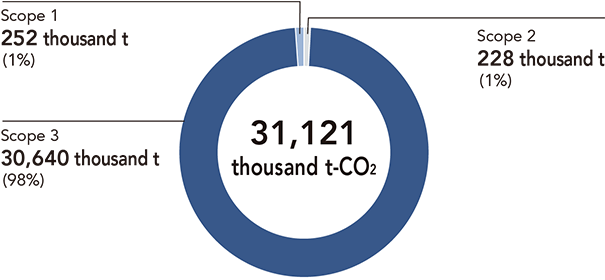
CO2 Emissions by Organization
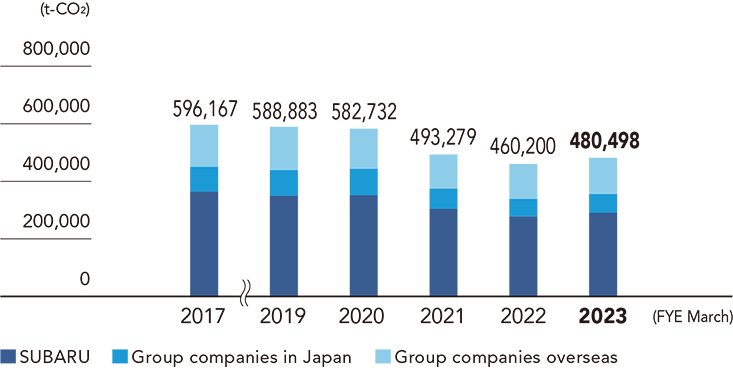
CO2 Emissions by Scope
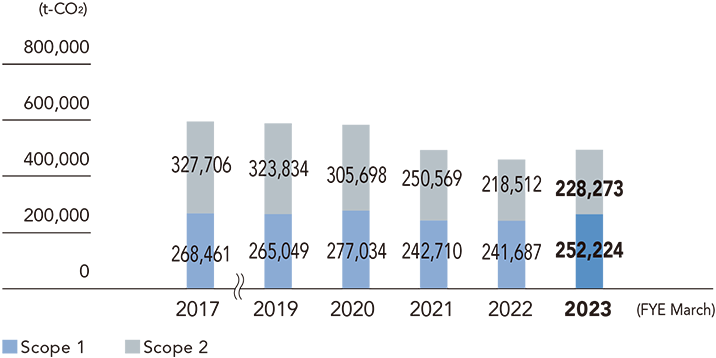
Scope:
- SUBARU:
- SUBARU CORPORATION
- Group companies in Japan:
- 52 domestic consolidated subsidiaries (including 33 SUBARU domestic dealerships that are consolidated subsidiaries)
- Group companies overseas:
- Subaru of Indiana Automotive, Inc., Subaru of America, Inc., Subaru of Canada, Inc., Subaru Research & Development, Inc.
SUBARU calculates CO2 emissions based on the Act on Promotion of Global Warming Countermeasures. However, emission factors for electricity at Group companies overseas are based on the most recent country-specific CO2 emission intensities for all power sources published annually by the International Energy Agency (IEA).
Consolidation of data from the Group's domestic companies into the scope of subsidiaries with 99% certainty of Scope 1 and Scope 2 emissions (percentage based on number of employees).
Due to errors in the electricity consumption of some Group companies in Japan, results for previousfiscal years have been revised.
Energy use
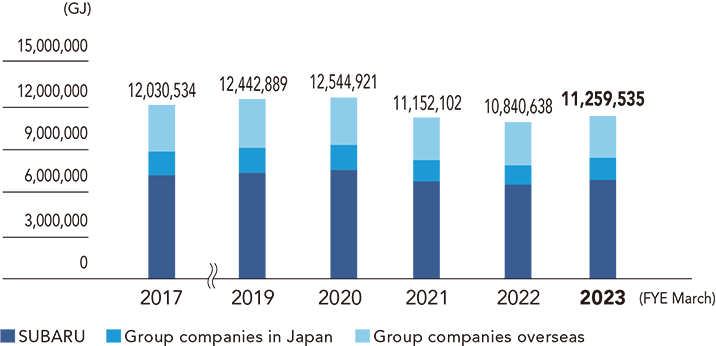
Scope:
- SUBARU:
- SUBARU CORPORATION
- Group companies in Japan:
- 52 domestic consolidated subsidiaries (including 33 SUBARU domestic dealerships that are consolidated subsidiaries)
- Group companies overseas:
- Subaru of Indiana Automotive, Inc., Subaru of America, Inc., Subaru of Canada, Inc., Subaru Research & Development, Inc.
SUBARU calculates energy consumption (GJ) based on the Act on the Rational Use of Energy.
Due to errors in the electricity consumption of some Group companies in Japan, results for past fiscal years have been revised.
CO2 Emissions (Scope 3)
| Category | Greenhouse Gas Emissions (t-CO2) | |||||
|---|---|---|---|---|---|---|
| FYE March 2019 | FYE March 2020 | FYE March 2021 | FYE March 2022 | FYE March 2023 | ||
| 1 | Purchased goods and services | 1,703,682 | 1,992,046 | 1,583,247 | 1,430,501 | 1,726,493 |
| 2 | Capital goods | 372,211 | 413,287 | 282,713 | 260,566 | 402,915 |
| 3 | Fuel- and energy-related activities not included in Scope 1 or Scope 2 | 102,022 | 103,772 | 91,851 | 89,627 | 95,352 |
| 4 | Transport and delivery (upstream) | 658,268 | 737,817 | 601,167 | 506,604 | 426,929 |
| 5 | Waste generated in operations | 31,984 | 32,095 | 26,446 | 24,888 | 28,733 |
| 6 | Business travel | 4,446 | 4,554 | 4,689 | 4,798 | 4,878 |
| 7 | Employee commuting | 13,506 | 13,835 | 14,245 | 14,576 | 14,818 |
| 8 | Leased assets (upstream) | N/A | N/A | N/A | N/A | N/A |
| 9 | Transportation, distribution, and sales (downstream) | 13,283 | 6,049 | 3,893 | 4,750 | 4,043 |
| 10 | Processing of sold products | N/A | N/A | N/A | N/A | N/A |
| 11 | Use of sold products | 33,298,769 | 34,029,045 | 27,455,302 | 23,102,609 | 27,453,385 |
| 12 | End-of-life treatment of sold products | 556,139 | 575,107 | 484,440 | 413,368 | 480,917 |
| 13 | Leased assets (downstream) | 2,394 | 2,463 | 1,998 | 2,065 | 1,984 |
| 14 | Franchises | N/A | N/A | N/A | N/A | N/A |
| 15 | Investments | N/A | N/A | N/A | N/A | N/A |
- Source:
- The calculation method for SUBARU Scope 3 emissions has been revised in reference to the Basic Guidelines on Accounting for Greenhouse Gas Emissions throughout the Supply Chain Ver. 2.3 (December 2017) by the Ministry of the Environment and the Ministry of Economy, Trade and Industry; the Emissions Unit Value Database Ver. 3.0 by the Ministry of the Environment Database of emissions unit values; and SUBARU’s life-cycle assessment (LCA) calculation standards.
In Category 11 (Use of sold products), emissions were previously calculated on a tank-to-wheel basis, but starting in FYE March 2023, emissions have been calculated on a well-to-wheel basis, and emissions during BEV use are also included in calculations. Revisions have been made to reflect this in data from previous fiscal years.
In addition, for Category 3 (Fuel- and energy-related activities not included in Scope 1 or Scope 2), due to errors in the electricity consumption of some Group companies in Jaoan, results for previous fiscal years have been revised.
Initiatives
SUBARU is reducing its CO2 emissions by using renewable energy and upgrading to highly efficient machinery and equipment with the aim of achieving carbon neutrality by 2050. Renewable energy in FYE March 2023 accounted for 6.1% of the energy consumption of the entire SUBARU Group and 18.6% of its total electricity consumption. All of the electricity purchased at the Gunma Main Plant, Utsunomiya South Plant and 2nd South Plant, the Ebisu Subaru Building, and the Subaru Training Center is carbon-neutral electric power.
In addition, Subaru Kohsan Co., Ltd. sells solar generated from solar power generation facilities in Gunma and Shiga prefectures.
CO2 reduction impact of various measures in FYE March 2023
| Measure | CO2 reduction impact (t-CO2) |
|---|---|
| Generation of renewable energy (solar power generation) | 4,529 |
| Purchase of carbon-neutral electricity | 47,197 |
| Introduction of high-efficiency air-conditioning systems | 2,000 |
| Replacement of cogeneration facilities | 3,712 |
| Energy conservation through information and communications technology (ICT)/IoT | 500 |
| Use of Green Power and Green Heat Certificates | 3,962 |
| Total | 61,900 |
Gunma Plant:
Purchase of Carbon-Neutral Electricity (Gunma Main Plant, Oizumi Plant)
The Gunma Main Plant had been purchasing a portion of its electricity through the Aqua Premium rate plan specifically for sales of hydropower, but switched to the Power supply Gunma Hydropower Plan in November 2020. All of its electricity is now derived from hydropower, which reduced CO2 emissions by approximately 26,500 tons in FYE March 2023.
We also reduced CO2 emissions by 4,907 tons by using non-fossil fuel energy certificates for 10,762 MWh of electricity at the Oizumi Plant of Gunma Manufacturing Co., Ltd. purchased in FYE March 2023, comprising 7.6% of purchased electricity.
Introduction of High-efficiency Air-conditioning Systems (Gunma Yajima Plant)
We replaced the aging cooling water supply system of the 3rd Paint Plant. In April 2022, the plant, which had previously used an absorption chiller with city gas as the heat source, introduced a centrifugal chiller with an electrically operated heat pump. In July, the plant began operation of a gas-fired absorption chiller with warm water from the cogeneration facility as the heat source. These cooling water supply system upgrades have eliminated our use of city gas.
In 2018, the 5th Paint Plant also introduced a high-efficiency heat source system, centered on heat pumps for cold and hot water supply to reduce CO2 emissions. SUBARU plans to roll out this system to the Oizumi New Plant, which is scheduled for future operation.
Replacement of Cogeneration Facilities
At the Gunma Plant, we operate cogeneration facilities at the Main Plant, Oizumi Plant, and Yajima Plant to promote efficient energy use.
In FYE March 2023, the aging facilities at the Oizumi Plant were updated after 15 years of operation, and the new facilities began operation in June 2022. For the replacement, we selected equipment with specifications that make a greater contribution to energy savings in light of the most recent energy consumption profile. Compared to the previous facilities, the new facilities offer annual emissions reduction of 3,712 t-CO2, according to their specifications.
Introduction of solar power generation
We have introduced solar power generation facilities at the Gunma Main Plant and Oizumi Plant. These facilities achieved a CO2 emissions reduction of approximately 3,142 t-CO2 in FYE March 2023. Solar power generation equipment will be incorporated into new building rooftops from the specification stage, and we are considering expanding this to existing buildings and parking lots over time.
In addition, since June 2022, solar power generation facilities with a total output of 1,430 kW have been in operation at the Yajima Plant, including at the multistoryparking garage and No. 5 final vehicle inspection wing, resulting in a reduction in CO2 emissions of 748 t-CO2.
Aerospace Company (Utsunomiya Plant and Handa Plant)
Purchase of carbon-neutral electricity
(Tochigi Furusato Denki Program for local production and consumption)
In FYE March 2019, SUBARU’s Aerospace Company adopted the Tochigi Furusato Denki program*1 to provide electricity to its Utsunomiya South and 2nd South Plants. The program offers electricity from hydropower generation projects owned by Tochigi Prefecture, and represents Japan’s first-ever power supply program themed on the “local production for local consumption” concept.
The above program enables the two plants to reduce emissions by an average of 4,000-plus t-CO2 per year. This program also includes a scheme to spend part of the funds from bill payment, including from SUBARU, on environmental conservation projects promoted in Tochigi Prefecture.
- *1
- Electricity service program co-hosted by the Tochigi Public Enterprise Bureau and TEPCO Energy Partner, Inc. Supplies electricity generated by eight hydroelectric power stations run by the Tochigi prefectural government. Hydropower users can claim to be emitting no CO2 from using the electricity, on the grounds of its CO2-free generation process.
Replacement of Cogeneration Facilities
In addition to reducing CO2 emissions, since March 2021 the cogeneration system has enhanced community and employee safety with its blackout start function that can initiate power generation if the power grid goes down for an extended period.
IoT Enables Stable Supply of Factory Air and Improved Energy Efficiency
SUBARU is moving forward with DX driven by ICT and the IoT beginning the systemization of air factory analysis, data analysis, and the introduction of countermeasures in November 2019. We have implemented three measures: investigating and repairing air leaks, restricting air supply, and improving operating efficiency. We expect energy savings to reduce CO2 emissions by 500 tons per year.
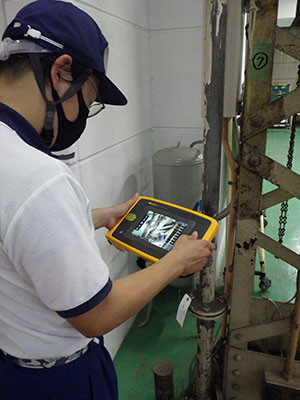
Improve Compressor Operating Efficiency
Tokyo Office
The Tokyo Office is in Mitaka City, Tokyo. It is subject to the Tokyo Cap-and-Trade Program for large facilities as per the Tokyo Metropolitan Environmental Security Ordinance. The Tokyo Office is therefore reducing CO2 emissions with two priority initiatives: promoting energy conservation by improving facilities and by proactively adopting energy-saving equipment.
We are also working to utilize renewable energy, and have installed rooftop solar power generation equipment (total rated output of 1,150 kW) at our facilities. In FYE March 2023, the facilities generated 93 MWh of electricity for use in-house, achieving a CO2 emissions reduction of 42 t-CO2. We purchased Green Power Certificates equivalent to 8,535 MWh of electric power, or CO2 emissions of 3,780 t-CO2, during the fiscal year.
In addition, a new office building was completed in October 2022. We have achieved annual CO2 emissions reduction of 20 to 25 t-CO2 by installing solar power generation systems and optimizing specifications for glass on the east and west sides of the building, fixtures, insulation, and other areas, creating thermal barriers and strong thermal insulation. In addition, creating cold mix asphalt during construction has contributed to a 38.5 t-CO2 reduction in CO2 emissions.
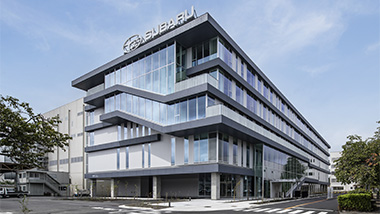
Offices
Head Office (Ebisu Subaru Building) and Subaru Training Center
Since FYE March 2022, we have switched to contract options with zero electricity emission coefficients, and we make use of the Green Heat Certificate system. In FYE March 2023, we achieved net-zero emissions for the office, carbon-neutralizing emissions equivalent to 883 t-CO2. In addition, from April 2023, all electricity used in the entire Ebisu Subaru Building has been switched to sources with zero CO2 emissions.
SUBARU Accessory Center
In FYE March 2023, the use of 1,046 MWh of electric power generated by solar power facilities installed in March 2020 resulted in a yearly CO2 emissions reduction of 477 t-CO2.
SUBARU Research and Experiment Center
The SUBARU Research and Experiment Center installed solar power generation equipment in FYE March 2018, and generated 78 MWh in FYE March 2023, resulting in a yearly CO2 emissions reduction of 36 t-CO2.
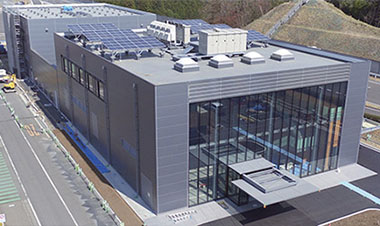
Group companies in Japan
Fuji Machinery Co., Ltd.
The Oizumi Plant of Fuji Machinery Co., Ltd. installed solar power generation equipment in FYE March 2018. In FYE March 2023, this equipment generated 35 MWh, resulting in a yearly CO2 emissions reduction of 16 t-CO2.
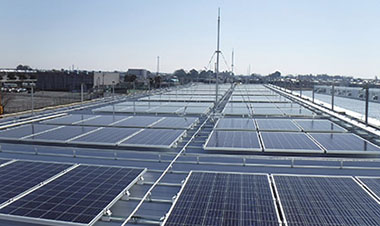
Ichitan Co., Ltd.
Ichitan Co., Ltd. has been reducing annual CO2 emissions by approximately 3,700 t-CO2 by purchasing carbon-free electricity.
Subaru Kohsan Co., Ltd.
Subaru Kohsan Co., Ltd. entered the business of marketing electricity from solar power generation operations. It sells electricity generated from solar power equipment with a rated output of 420 kW installed in Kiryu, Gunma Prefecture, and, as of March 2021, equipment with a rated output of 1,470 kW installed in Konan, Shiga Prefecture. The company has also promoted the use of renewable energy by installing solar power generation facilities at its Ota S Building and the new wing of its Higashi-Nagaoka company dormitory.
Subaru Kohsan Co., Ltd. has been certified as an excellent operator with respect to energy conservation (Class S) for four consecutive years since FYE March 2020 in accordance with the Act on the Rational Use of Energy. This evaluation is given to excellent operators that have met the five-year average per-unit emission reduction target of 1% or more in electricity and gas consumption.
Group companies overseas
Subaru of Indiana Automotive, Inc.
Subaru of Indiana Automotive, Inc.’s Technical Training Center has solar power generation equipment on its roof and LED lighting with motion sensors for all indoor lighting. In 2022, the company reduced electricity usage by replacing drive units, HVAC units, and lighting fixtures with more energy efficient alternatives.
Subaru of America, Inc.
Subaru of America, Inc.’s new headquarters and National Service Training Center have acquired silver LEED certification,*2 which is higher than standard certification. By installing automated equipment at its headquarters building and National Service Training Center in 2021, the company established comprehensive air-conditioning systems with more efficient energy utilization.
The headquarters building is notable for its use of 100% green and wind power-derived electricity, the installation of charging facilities ahead of the 2022 launch of SUBARU's first global BEV, theSolterra, and the use of efficient air conditioning systems and LED lighting. In April 2021, the company installed daylight harvesting technology in its headquarters foyer which achieves the appropriate level of brightness for the space by balancing natural light with just the required level of electric lighting, reducing energy consumption and CO2 emissions.
- *2
- Leadership in Energy and Environmental Design (LEED) certification is a green building certification system developed and operated by the U.S. Green Building Council (USGBC). It provides objective environmental performance data on buildings through evaluation of energy conservation and environmental impact reduction abilities for a range of project stages from overall planning and design to construction, management, and maintenance. Acquisition of the certification is becoming popular in the U.S. and in other countries.
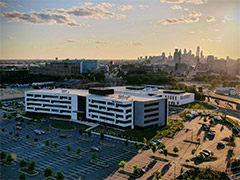
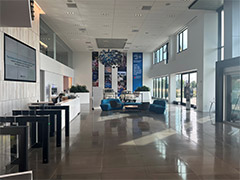
Subaru Canada, Inc.
The building that houses the relocated office of Scott Subaru, a retailer of Subaru Canada, Inc., from 2019 boasts a distinctive, highly energy-efficient design that enables comfort without an air-conditioning system. In recognition of this, the building is the world’s first retail facility to obtain a passive house certification.
Logistics
SUBARU is collaborating across the entire Group, including with logistics companies, dealerships, as well as with other automotive industry players to reduce CO2 emissions in logistics operations by an annual 1% through increased transport efficiency for finished vehicles and export parts.
In addition to the CO2 emissions from domestic logistics and the export of finished vehicles, in FYE March 2023 we identified CO2 emissions from the export of parts and parts supplies for overseas production. We will work to expand the scope of CO2 emissions identification, manage emissions in logistics processes, and further enhance supply chain management, which will contribute to carbon neutrality by 2050.
SUBARU’s logistics system
Transport of Finished Vehicles
SUBARU is establishing optimal standard routes for finished vehicles, flexibly accommodating shipping of a wide range of vehicle types and sizes (particularly large cars), improving loading efficiency, and promoting modal shift.*3 We also request that our logistics partners minimize the environmental impact of their transport operations, taking actions such as practicing eco-conscious driving by installing digital tachographs*4 and dash cams, as well as improving fuel efficiency by fitting aerodynamic panels and other devices.
As a result of expanded efforts for consolidated and standardized transportation routes, per unit CO2 emissions from transportation of SUBARU vehicles in FYE March 2023 declined 22.6% from the FYE March 2007 level, against the target of a 15% reduction from the base year. We will continue with our efforts to pursue further reductions.
- *3
- For cargo transportation, switching transportation modes from trucks to those imposing less environmental burden, such as railway and seaborne systems.
- *4
- Fitted to a vehicle to automatically record its journey information, including driving time and speed, and store the information in the installed recording medium, such as a memory card. The device is employed broadly by industries involving the commercial operation of vehicles as a tool for driving management. As the system can present clear data of recorded events, including sudden acceleration and deceleration, fuel-wasting engine idling, and dangerous driving, it is expected to help drivers increase their awareness of safe driving and fuel economy.
Export Parts
In the transport of parts for overseas SUBARU vehicle production, we are making efforts to improve the container fill rate through measures such as utilizing unused upper space in high cube containers, improving packing modes, and employing lighter-weight packaging materials. As a result, we achieved a fill rate of 98% in FYE March 2023.
In 2017, we began using the container round use system*5, which increases the efficiency of container transport. This enabled us to reduce emissions by 180 t-CO2 year on year in FYE March 2023. The use of inland container depots*6 has reduced emissions by 15 t-CO2 year on year in FYE March 2023. In the second half of 2020, we launched an initiative in the Gunma region to make active reuse of export containers previously used by another company, which achieved a year-on-year reduction of approximately 7 t-CO2 in FYE March 2023. We will continue to implement initiatives to reduce CO2 emissions.
- *5
- Using import containers for export instead of returning them empty to port, thereby reducing the transport of empty containers from ports.
- *6
- Depot located inland for consolidation of container cargo.
(FYE March)
| 2019 | 2020 | 2021 | 2022 | 2023 | |
|---|---|---|---|---|---|
| Container fill rate | 79% | 94% | 85% | 92% | 98% |
Parts and Accessories
- Joint distribution initiative with Toyota Mobility Parts Co., Ltd.
To resolve complexities and inefficiencies in parts of our transport system, we began joint distribution of maintenance parts with Toyota Mobility Parts Co., Ltd. in FYE March 2021. As of the end of FYE March 2023, we had started joint distribution to eight dealers (14 locations and sales partners in various regions). We aim to work toward joint distribution in other regions going forward.
By switching to joint distribution, we have in the case of some dealers achieved a reduction of lead time by one day and a cut in transport costs of approximately 25%. - Switch to forklift trucks with electric drive option
The Accessory Center in Gunma is making a phased switch from liquefied petroleum gas (LPG)-operated forklift trucks to models that can be operated electrically. We will also equip the electric forklift trucks to make them available for use as storage batteries in the event of a disaster or power outage so that they can be used in times of emergency for instance to maintain telecommunications functions.
Subaru of America, Inc.
The company is promoting the use of rail to reduce CO2 emissions in the distribution process. We are also working to reduce emissions from marine transportation to dealers in Alaska through the use of LNG. These efforts have resulted in a 25% reduction in CO2, a 95% reduction in NOx, and a 99% reduction in SOx.
Sales
When updating aging facilities, dealers in Japan are gradually switching to LED lighting and high-efficiency air conditioners. In addition to Tokyo Subaru Inc., Kanagawa Subaru Co. Ltd., and Chiba Subaru Inc., which had been purchasing carbon-neutral electricity until FYE March 2022, three SUBARU Group companies in the Tokai region (Nagoya Subaru Motors, Inc., Gifu Subaru Motors Inc., and Mie Subaru Motors Inc.) have also started purchases as of November 30, 2022. In FYE March 2023, switching purchased electricity resulted in reductions of 5,791 t-CO2.
We will continue to pivot to decoupling energy consumption and CO2 emissions with initiatives to create environmentally responsible dealers that care about people.
Carbon Pricing
Emissions Trading Systems
As businesses operating in the jurisdictions of the Tokyo metropolitan and Saitama prefectural governments, our Tokyo Office, Kitamoto Plant, and Stellar Town Omiya are covered by the Tokyo Metropolitan Environmental Security Ordinance, which promotes greenhouse gas reduction and emissions trading for large businesses, and the Saitama Prefecture regulation on target-based emissions trading. Our business sites are responding through compliance with the relevant emissions trading systems.
Internal Carbon Pricing
SUBARU introduced internal carbon pricing in FYE March 2023. In the internal consultative plan on capital expenditures at business sites, the monetary value of the CO2 reduction accompanying the introduction of the relevant facilities is set at 6,000 yen/ton. By accounting for CO2 reduction impact in terms of its cost reduction impact, we ensure its inclusion as a factor in assessing capital expenditures. The introduction of internal carbon pricing, which comes under the category of shadow pricing, is intended not only to raise awareness of CO2 reduction among facility managers but also to promote investment in facilities with a high CO2 reduction impact.
External Partnerships
SUBARU is tackling the climate change challenge through partnerships with suppliers, customers, and industry groups.
Alliance with Toyota Motor Corporation
SUBARU and Toyota Motor Corporation (“Toyota”) have agreed to jointly develop EV platforms and vehicles applying SUBARU’s AWD technologies and Toyota’s electrification technologies. This agreement is designed to enable the two automakers to multiply their technical strengths with the goal of creating attractive EV products. As a dedicated BEV platform, they have jointly developed the e-SUBARU Global Platform.
Business Partners
We have set out a code of conduct that requires supplier selection and management mechanisms relating to climate change issues, and share the code with our suppliers, asking them to take appropriate actions when providing orientation sessions.
By encouraging business partners to obtain ISO 14001 certification, we are working to prevent environmental accidents and mismanagement events in the supply chain and reduce the risk of infringement of environmental laws and regulations.
As a new initiative, in FYE March 2023 we also conducted on-demand briefings targeting 320 business partners with the aim of realizing decarbonization in the supply chain. During these briefings, we shared SUBARU’s CO2 emissions reduction targets with the business partners. Furthermore, we received CO2 emissions reports from 287 business partners (representing 90% of the total and 99% in terms of transaction value), allowing us to visualize the CO2 emissions for each of our business partners. We also conducted a trial calculation of CO2 emissions at the component level for selected business partners.
Industry Groups
SUBARU is a member of the climate change committee of Japan Automobile Manufacturers Association, Inc. (JAMA). Also, the President and Executive Vice Presidents are JAMA directors responsible for the body’s executive decision making, and decisions made by JAMA are reflected in SUBARU’s mid-term management vision.
Declaration of Support for the TCFD Recommendations
SUBARU recognizes that climate change is one of the most pressing global issues, and has been working to disclose information on climate change. Most recently in this area, it has declared support for the recommendations of the Task Force on Climate-related Financial Disclosures (TCFD). For more information on SUBARU’s disclosure of the TCFD’s recommended items, please see our TCFD Content Index (https://www.subaru.co.jp/en/csr/tcfd/).

